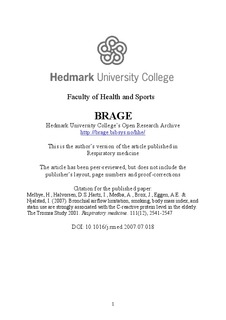Bronchial airflow limitation, smoking, body mass index, and statin use are strongly associated with the C-reactive protein level in the elderly. The Tromsø Study 2001
Melbye, Hasse; Halvorsen, Dag; Hartz, Ingeborg; Medbøe, Astri; Brox, Jan; Eggen, Anne Elise; Njølstad, Inger
Journal article, Peer reviewed
Permanent lenke
http://hdl.handle.net/11250/134188Utgivelsesdato
2007Metadata
Vis full innførselSamlinger
Originalversjon
Melbye, H., Halvorsen, D.S.,Hartz, I., Medbø, A., Brox, J., Eggen, A.E. & Njølstad, I. (2007). Bronchial airflow limitation, smoking, body mass index, and statin use are strongly associated with the C-reactive protein level in the elderly. The Tromsø Study 2001. Respiratory medicine. 111(12), 2541-2547 http://dx.doi.org/10.1016/j.rmed.2007.07.018Sammendrag
Background: Bronchial airflow limitation is a known predictor of raised C-reactive protein (CRP) level. The aim of this study was to explore this association in an elderly population, as well as the influence of other known and possible predictors of the CRP level, like smoking and the use of statins and inhaled corticosteroids.
Population and Methods: The study population consists of 3877 Norwegians aged 60 years or more who took part in the fifth Tromsø study in 2001, a cross-sectional study. The examinations included questionnaires, spirometry and the measurement of CRP.
Results: A geometric mean CRP value of 3.15 mg/L was found in subjects with severe airflow limitation (FEV1 % < 50 predicted and FEV1/FVC <70%), compared to 1.64 mg/L in subjects with normal spirometry, (p<0.001), and 19% of the subjects with severe airflow limitation had a CRP value above 10 mg/L compared to 4.9% in those with mild airflow limitation or normal spirometry. Elevated body mass index (BMI), smoking, hormone replacement therapy, and increasing age, were also strong independent predictors of increased CRP. Statin use was a strong predictor of decreased CRP level, while the use of inhaled corticosteroids was not associated with decreased CRP values.
Conclusion: We found a strong link between bronchial airflow limitation and the circulating CRP level in an elderly population, independent of self-reported diseases, medication, smoking, and elevated BMI. The CRP value increased with increasing age in men, but not in women, which may be partly explained by a greater impact of COPD morbidity on the CRP level in men than in women. Measuring CRP may show to be a useful part of the diagnostic work-up in COPD patients.
Beskrivelse
The original publication is available at: http://dx.doi.org/10.1016/j.rmed.2007.07.018
